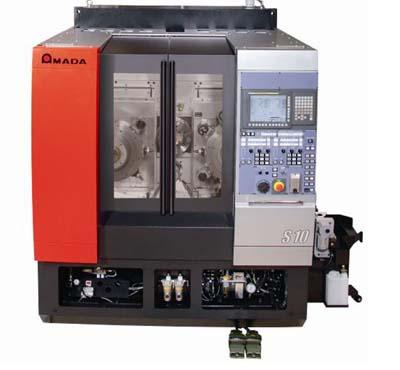
A new multi-tasking turning/milling center has a variety of modular options that tailor it to exactly those functions that are needed for a user's range of parts. With two turrets, 8- or 12-stations each, one main spindle and an optional sub-spindle, Amada Machine Tools America says its new S-10 can do more in one loading, often with simultaneous machining from live spindles on each turret. Multiple part-loading options, optional live spindles and turning-tool holders, and the sub-spindle can be selected as individual modules and combined to handle an extraordinary range of parts configurations and sizes.
The S-10 reflects Amada Wasino's decade-long experience with multi-function, multi-live-spindle machines, combining an improved ergonomic design in which the main spindle faces the operator; higher productivity with twin turrets; and a choice of gantry loading, bar-feeding, or manual loading. A reversing vise and the sub-spindle offer alternative ways to work both ends of a part in one loading. Parts are chucked in the main spindle, which provides standard turning, indexing for multi-side milling, drilling, boring and threading, and full C-axis continuous motion for contour milling. In coordination with the C-axis, each turret is independently capable of simultaneous three-axis motion.
Advances in this new machine configuration fall primarily into two areas: A wider variety of machining and part-handling functions, and steps to enhance automation.
In the first category are modular machining heads and quick-change toolholders. Milling/drilling heads, which take their drive from countershafts that run through the turret, are offered in high-torque X-axis and Z-axis versions, which approach the work from perpendicular planes. An angular drilling head uses the turrets' multi-axis motion to drill holes at angles ranging from 8 to 35°From the primary machine axes. Quick-change turning and boring toolholders that use standard Sandvik Coromant tooling, and a polygon tool holder and cutters that allow multi-axis turning of flat faces, a quicker process than milling, in many instances, for machining flat faces on the work, are additional modular options.
The machine's primary claim to productivity is the twin-turret configuration, which can double the normal milling and turning throughput of a multi-tasking machine. Back-side machining with cutoff capability avoids the need for separate setups or offline second-operation machining. In addition, a dedicated, on-board toolsetting device; an on-board video camera for remote monitoring; and simulation software for testing an entire program in virtual space, speed the non-cutting, setup and running of the machine. A variety of work-staging and offloading options are available for the gantry loader and for bar-feeding.
The S-10 pushes the throughput capabilities of a class of machine tool that is already noted for its versatile machining capability in a compact space. With a footprint of only 67 inches by 79 inches, it will reportedly perform more operations, automatically, than two, three, or more conventional machine tools.
Contact Details
Related Glossary Terms
- boring
boring
Enlarging a hole that already has been drilled or cored. Generally, it is an operation of truing the previously drilled hole with a single-point, lathe-type tool. Boring is essentially internal turning, in that usually a single-point cutting tool forms the internal shape. Some tools are available with two cutting edges to balance cutting forces.
- cutoff
cutoff
Step that prepares a slug, blank or other workpiece for machining or other processing by separating it from the original stock. Performed on lathes, chucking machines, automatic screw machines and other turning machines. Also performed on milling machines, machining centers with slitting saws and sawing machines with cold (circular) saws, hacksaws, bandsaws or abrasive cutoff saws. See saw, sawing machine; turning.
- flat ( screw flat)
flat ( screw flat)
Flat surface machined into the shank of a cutting tool for enhanced holding of the tool.
- gang cutting ( milling)
gang cutting ( milling)
Machining with several cutters mounted on a single arbor, generally for simultaneous cutting.
- milling
milling
Machining operation in which metal or other material is removed by applying power to a rotating cutter. In vertical milling, the cutting tool is mounted vertically on the spindle. In horizontal milling, the cutting tool is mounted horizontally, either directly on the spindle or on an arbor. Horizontal milling is further broken down into conventional milling, where the cutter rotates opposite the direction of feed, or “up” into the workpiece; and climb milling, where the cutter rotates in the direction of feed, or “down” into the workpiece. Milling operations include plane or surface milling, endmilling, facemilling, angle milling, form milling and profiling.
- threading
threading
Process of both external (e.g., thread milling) and internal (e.g., tapping, thread milling) cutting, turning and rolling of threads into particular material. Standardized specifications are available to determine the desired results of the threading process. Numerous thread-series designations are written for specific applications. Threading often is performed on a lathe. Specifications such as thread height are critical in determining the strength of the threads. The material used is taken into consideration in determining the expected results of any particular application for that threaded piece. In external threading, a calculated depth is required as well as a particular angle to the cut. To perform internal threading, the exact diameter to bore the hole is critical before threading. The threads are distinguished from one another by the amount of tolerance and/or allowance that is specified. See turning.
- turning
turning
Workpiece is held in a chuck, mounted on a face plate or secured between centers and rotated while a cutting tool, normally a single-point tool, is fed into it along its periphery or across its end or face. Takes the form of straight turning (cutting along the periphery of the workpiece); taper turning (creating a taper); step turning (turning different-size diameters on the same work); chamfering (beveling an edge or shoulder); facing (cutting on an end); turning threads (usually external but can be internal); roughing (high-volume metal removal); and finishing (final light cuts). Performed on lathes, turning centers, chucking machines, automatic screw machines and similar machines.
